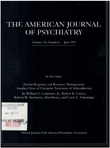The effect of acetazolamide on ventilation in panic disorder patients
Abstract
OBJECTIVE: Patients with panic disorder are behaviorally hypersensitive to CO2 inhalation and may also be biologically hypersensitive. A report by Mathew et al. showed, however, that administration of the carbonic anhydrase inhibitor acetazolamide, which is believed to increase brain CO2 level, did not cause panic in panic disorder patients. The authors of the present study noted that respiratory frequency did not increase in the earlier experiment and wondered whether respiratory stimulation occurred during acetazolamide administration, as would be expected if CO2 level increases significantly. METHOD: Ten patients with panic disorder and six normal control subjects received injections of acetazolamide, 1 g i.v., as per the Mathew et al. protocol, during breath by breath measurement of both tidal volume and frequency of respiration. RESULTS: Three patients had panic attacks, one before receiving acetazolamide, one during the injection, and one 2 minutes after injection. Only the last of these attacks appeared possibly attributable to acetazolamide. None of the control subjects panicked. Neither patients nor control subjects exhibited meaningful change in tidal volume, respiratory frequency, or minute ventilation, and both groups experienced a trend toward significant decrease in overall levels of anxiety and dyspnea after acetazolamide injection. CONCLUSIONS: The authors replicated the earlier finding that acetazolamide is not panicogenic in patients with panic disorder but also showed that at the dose given, there is no meaningful effect on ventilation. If acetazolamide does affect CO2 levels it does so in a way that does not stimulate ventilation. Therefore, the acetazolamide injection results of Mathew et al. and of the present study do not challenge hypotheses linking panic attacks to hypersensitive respiratory control mechanisms.
Access content
To read the fulltext, please use one of the options below to sign in or purchase access.- Personal login
- Institutional Login
- Sign in via OpenAthens
- Register for access
-
Please login/register if you wish to pair your device and check access availability.
Not a subscriber?
PsychiatryOnline subscription options offer access to the DSM-5 library, books, journals, CME, and patient resources. This all-in-one virtual library provides psychiatrists and mental health professionals with key resources for diagnosis, treatment, research, and professional development.
Need more help? PsychiatryOnline Customer Service may be reached by emailing [email protected] or by calling 800-368-5777 (in the U.S.) or 703-907-7322 (outside the U.S.).



